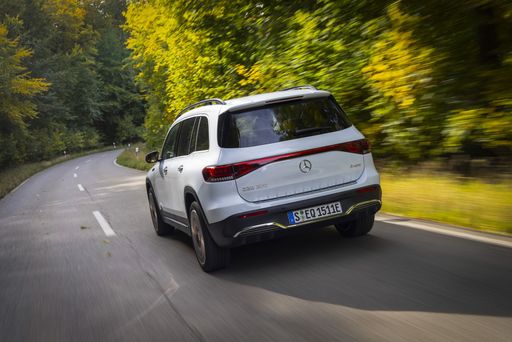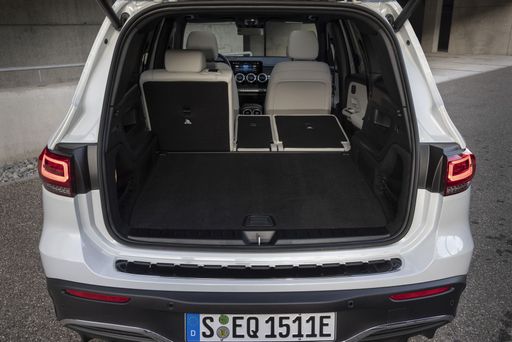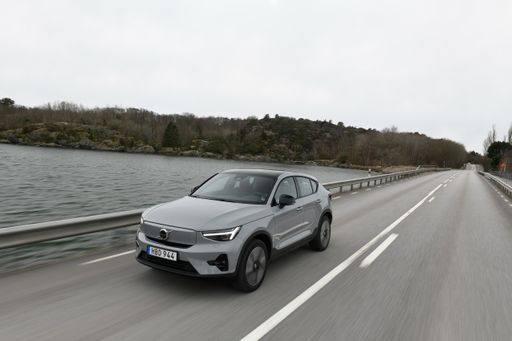Mercedes EQB vs Volvo EC40 – Differences & prices compared
Compare performance, boot space, consumption and price in one view.
Find out now: which car is the better choice for you – Mercedes EQB or Volvo EC40?
The Mercedes EQB (SUV) comes with a Electric engine and Automatic transmission. In comparison, the Volvo EC40 (SUV) features a Electric engine with Automatic transmission.
When it comes to boot capacity, the Mercedes EQB offers 495 L, while the Volvo EC40 provides 404 L – depending on how much space you need. If you’re looking for more power, decide whether the 292 HP of the Mercedes EQB or the 442 HP of the Volvo EC40 suits your needs better.
In terms of consumption, the values are 15.20 kWh per 100 km for the Mercedes EQB, and 16.30 kWh for the Volvo EC40.
Price-wise, the Mercedes EQB starts at 45900 £, while the Volvo EC40 is available from 46600 £. Compare all the details and find out which model fits your lifestyle best!
In the battle of electric SUVs, the Mercedes EQB and the Volvo EC40 each bring unique strengths to the table. The EQB impresses with its spacious interior and luxurious features, catering to families seeking comfort in an eco-friendly package. Meanwhile, the EC40 stands out with its minimalist design and advanced safety technology, appealing to those who prioritize style and innovation in their driving experience.
Mercedes EQB
The Mercedes-Benz EQB is an all-electric compact SUV that seamlessly blends practicality with modern luxury. Its sleek design and spacious interior make it an attractive option for families seeking both style and function. With advanced technology and impressive range capabilities, the EQB is a testament to Mercedes-Benz's commitment to sustainable mobility.
details @ group-media.mercedes-benz.com
@ group-media.mercedes-benz.com
 @ group-media.mercedes-benz.com
@ group-media.mercedes-benz.com
 @ group-media.mercedes-benz.com
@ group-media.mercedes-benz.com
 @ group-media.mercedes-benz.com
@ group-media.mercedes-benz.com
 @ group-media.mercedes-benz.com
@ group-media.mercedes-benz.com
Volvo EC40
The Volvo EC40 seamlessly combines cutting-edge technology with sleek Scandinavian design, offering a refined driving experience. With its advanced safety features and user-friendly infotainment system, this model caters to both seasoned drivers and modern tech enthusiasts. The vehicle's impressive efficiency and environmentally conscious engineering make it a standout choice for those seeking sustainability without compromising on style.
details @ media.volvocars.com
@ media.volvocars.com
The automotive landscape is rapidly evolving, especially in the electric vehicle (EV) segment. Two noteworthy contenders making waves are the Mercedes EQB and the Volvo EC40. Both vehicles offer distinctive features, advanced technologies, and compelling performance for eco-conscious drivers. This comparison will delve into the technical aspects and innovations that set these two electric SUVs apart.
Design and Dimensions
Starting with design, the Mercedes EQB showcases a classic yet futuristic silhouette emblematic of the brand's luxury ethos. With dimensions measuring 4684 mm in length, 1834 mm in width, and a height ranging from 1654 mm to 1689 mm, it offers a robust and spacious interior. The EQB comfortably seats five and boasts a generous trunk capacity of 495 liters.
On the other hand, the Volvo EC40 presents a sleek, sporty appearance with a compact design, measuring 4440 mm in length, 1873 mm in width, and 1591 mm in height. This SUV also accommodates five passengers but has a slightly smaller trunk capacity of 404 liters. The EC40’s design reflects Volvo's commitment to minimalism without sacrificing functionality.
Performance and Powertrain
When it comes to performance, the Mercedes EQB offers several configurations. The power outputs range from 190 HP to 292 HP, with acceleration from 0 to 100 km/h as swift as 6.2 seconds. The EQB comes in both front-wheel and all-wheel-drive variants, catering to different driving preferences. In contrast, the Volvo EC40 steps up with power ratings from 238 HP to an impressive 408 HP, achieving 0 to 100 km/h in a mere 4.6 seconds in its most potent form. Notably, it features both rear-wheel and all-wheel-drive options as well.
Torque figures reveal a compelling narrative as well, with the EQB delivering up to 520 Nm, while the EC40 surpasses that with a maximum torque of 670 Nm in its top configuration, emphasizing the latter’s performance edge in dynamic driving conditions.
Range and Efficiency
Electric range is crucial for any EV, and both models excel in this field. The EQB offers an impressive electric range of up to 533 km with a 70.5 kWh battery. In various configurations, the efficiency remains competitive, consuming between 15.2 and 17.3 kWh per 100 km.
The EC40, while just slightly less in maximum range at 584 km, utilizes its 79 kWh battery efficiently, with consumption figures ranging from 16.2 to 17.3 kWh per 100 km. This slight edge in range, combined with innovative battery technology, reinforces Volvo's reputation in the electric segment.
Technology and Features
The technological innovations in both vehicles are noteworthy. The Mercedes EQB is equipped with the latest MBUX infotainment system, featuring voice activation, a wide array of connectivity options, and advanced driver assistance systems. The aesthetic interface provides seamless interaction and enhances the overall driving experience.
Conversely, Volvo's EC40 incorporates the Android Automotive OS, delivering a unique user experience with built-in Google services, including Google Assistant, Google Maps, and the Google Play Store. This integration allows for seamless updates and the ability to download apps directly to the vehicle, a first in the automotive industry.
Sustainability and Safety
Both brands place an emphasis on sustainability and safety. The Mercedes EQB is built with recyclable materials and has garnered an A rating in CO2 efficiency, echoing the brand's commitment to environmentally friendly production methods.
Meanwhile, the Volvo EC40 stands firm on its safety credentials, being equipped with state-of-the-art safety features and having a strong focus on protecting both occupants and pedestrians. Volvo is renowned for its safety innovations, making the EC40 a fitting addition to its legacy.
Conclusion
In summary, the choice between the Mercedes EQB and the Volvo EC40 ultimately boils down to personal preference. The EQB offers a larger interior, a luxurious aesthetic, and varied powertrain options, while the EC40 impresses with its sporty design, cutting-edge technology, and robust performance. Both vehicles represent significant progress in the electric SUV market, promising a thrilling ride for those ready to embrace the future of automotive innovation.

|

|
|
|
|
Costs and Consumption |
|
|---|---|
|
Price
45900 - 58900 £
|
Price
46600 - 59000 £
|
|
Consumption L/100km
-
|
Consumption L/100km
-
|
|
Consumption kWh/100km
15.2 - 17.2 kWh
|
Consumption kWh/100km
16.3 - 17.3 kWh
|
|
Electric Range
468 - 535 km
|
Electric Range
487 - 583 km
|
|
Battery Capacity
70.50 kWh
|
Battery Capacity
67 - 79 kWh
|
|
co2
0 g/km
|
co2
0 g/km
|
|
Fuel tank capacity
-
|
Fuel tank capacity
-
|
Dimensions and Body |
|
|---|---|
|
Body Type
SUV
|
Body Type
SUV
|
|
Seats
5
|
Seats
5
|
|
Doors
5
|
Doors
5
|
|
Curb weight
2105 - 2170 kg
|
Curb weight
2065 - 2185 kg
|
|
Trunk capacity
495 L
|
Trunk capacity
404 L
|
|
Length
4684 mm
|
Length
4440 mm
|
|
Width
1834 mm
|
Width
1873 mm
|
|
Height
1654 - 1689 mm
|
Height
1591 mm
|
|
Payload
435 kg
|
Payload
395 - 435 kg
|
Engine and Performance |
|
|---|---|
|
Engine Type
Electric
|
Engine Type
Electric
|
|
Transmission
Automatic
|
Transmission
Automatic
|
|
Transmission Detail
Reduction Gearbox
|
Transmission Detail
Reduction Gearbox
|
|
Drive Type
Front-Wheel Drive, All-Wheel Drive
|
Drive Type
Rear-Wheel Drive, All-Wheel Drive
|
|
Power HP
190 - 292 HP
|
Power HP
238 - 442 HP
|
|
Acceleration 0-100km/h
6.2 - 8.9 s
|
Acceleration 0-100km/h
4.6 - 7.3 s
|
|
Max Speed
160 km/h
|
Max Speed
180 km/h
|
|
Torque
385 - 520 Nm
|
Torque
420 - 670 Nm
|
|
Number of Cylinders
-
|
Number of Cylinders
-
|
|
Power kW
140 - 215 kW
|
Power kW
175 - 325 kW
|
|
Engine capacity
-
|
Engine capacity
-
|
General |
|
|---|---|
|
Model Year
2024 - 2025
|
Model Year
2024
|
|
CO2 Efficiency Class
A
|
CO2 Efficiency Class
A
|
|
Brand
Mercedes-Benz
|
Brand
Volvo
|
Mercedes EQB
Introducing the Mercedes-Benz EQB: A New Era in Electric SUVs
The Mercedes-Benz EQB is a striking testament to the innovative prowess of Mercedes-Benz in the realm of electric vehicles. As an SUV designed for the future, the EQB merges luxury with sustainability, offering a remarkable driving experience complemented by state-of-the-art technology.
Powerful Performance and Efficient Design
Under the bonnet, the EQB is powered by an electric motor that produces between 190 to 292 PS, translating to 140 to 215 kW. This powerful engine allows the EQB to achieve a 0-100 km/h acceleration in just 6.2 to 8.9 seconds, rivaling many other vehicles in its class.
Fuel efficiency remains at the forefront of the EQB's design, with a consumption rate ranging from 15.2 to 17.3 kWh per 100 km. This efficiency ensures the vehicle maintains an impressive electric range between 445 to 533 km per charge, giving drivers the confidence to embark on longer journeys without constant recharging.
Cutting-Edge Technological Innovations
The EQB is packed with innovations that make driving an intuitive and seamless experience. The vehicle boasts a state-of-the-art emissions rating of zero CO2 per km, proudly placing it in the A class of CO2 efficiency. The integrated automatic transmission, specifically the Reduktionsgetriebe, offers smooth transitions and enhances overall driving comfort.
Roomy Interior and Premium Features
Step inside the EQB to find a spacious and luxurious interior, capable of accommodating five passengers comfortably. With a luggage capacity of 495 litres, this SUV caters to both adventure and everyday needs. The EQB comes available in several exquisite lines, including AMG Line Advanced and Electric Art Advanced Plus, ensuring there's a version to match every style preference.
Safety and Reliability
Safety has always been a priority for Mercedes-Benz, and the EQB continues this legacy. With an all-wheel-drive option on certain models, enhanced traction and stability are provided across a variety of driving conditions. Furthermore, the EQB's substantial weight range from 2105 to 2170 kg adds to its robust and stable feel on the road.
Pricing and Ownership Costs
The price of the EQB starts at €53,514, and the top-end models can go up to €68,734. Mercedes-Benz offers several financing options to suit various budgets, with running costs calculated at approximately 47.4 to 55.9 cents per kilometre, making it an economically viable choice for the environmentally conscious driver.
The Mercedes-Benz EQB is more than just a vehicle; it represents a shift towards a more sustainable future, without compromising on luxury or performance. Whether you're navigating city streets or venturing into the countryside, the EQB is engineered to deliver an exceptional driving experience every time.
Volvo EC40
Introduction to the Volvo EC40
The Volvo EC40 has emerged as a standout model in the electric SUV market, embodying a splendid fusion of Scandinavian design and state-of-the-art technology. As part of Volvo’s endeavour towards a sustainable future, the EC40 caters to environmentally conscious drivers who seek a blend of performance, luxury, and innovation.
Powertrain and Performance
The Volvo EC40 is available in both rear-wheel and all-wheel drive configurations, offering a flexible choice for various driving preferences. The model is powered by robust electric motors, with outputs ranging from 238 to 408 PS (175 to 325 kW). This range of power allows for a diverse driving experience, featuring a brisk acceleration from 0 to 100 km/h between 4.6 and 7.3 seconds, appealing to enthusiasts of spirited driving.
Fuel efficiency is a significant advantage of the EC40, boasting a consumption between 16.2 and 17.3 kWh per 100 km. Moreover, the vehicle's electric range impresses with figures stretching from 487 to 584 km, ensuring that long drives are as feasible as they are economical.
Innovative Battery Technology
Equipped with high-capacity batteries ranging from 67 to 79 kWh, the Volvo EC40 leverages advanced battery technology to offer reliability and longevity. This innovation helps in maintaining exceptional energy efficiency while adhering to Volvo’s commitment to reducing environmental impact.
Design and Dimensions
The signature Scandinavian design of the EC40 embodies elegance through its simplistic yet luxurious aesthetics. Its dimensions — 4440 mm in length, 1873 mm in width, and 1591 mm in height — are crafted to provide optimal space and comfort without compromising sleekness. The interior accommodates up to five passengers comfortably, with a boot offering a 404-litre capacity, making it ideal for adventure trips or daily commutes.
Safety and Technology
Volvo has long been synonymous with safety, and the EC40 continues this legacy with an array of advanced safety and driver assistance technologies. The SUV is equipped with cutting-edge features such as automated emergency braking, lane-keeping assistance, and BLIS (Blind Spot Information System), designed to ensure a stress-free and secure driving experience.
Conclusion
The Volvo EC40 stands as a testament to Volvo's dedication to innovation in the automotive industry. With an excellent blend of performance, technology, and efficiency, alongside impressive environmental credentials — including a CO2 efficiency class of A and zero emissions — the EC40 represents a beacon of Volvo’s sustainable future in electric mobility.
Which drive types are available for the Mercedes EQB?
Available as Front-Wheel Drive or All-Wheel Drive.
The prices and data displayed are estimates based on German list prices and may vary by country. This information is not legally binding.
